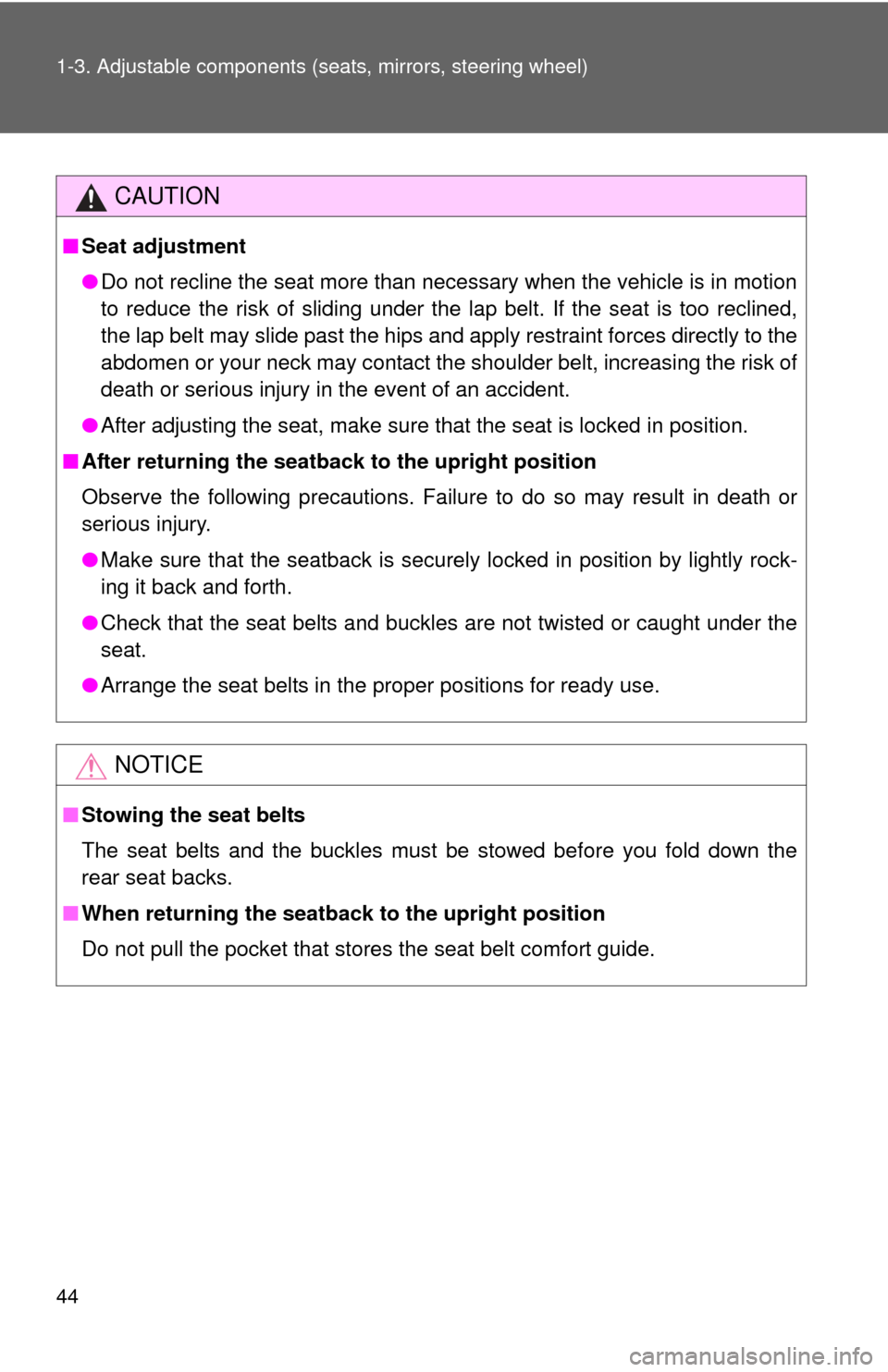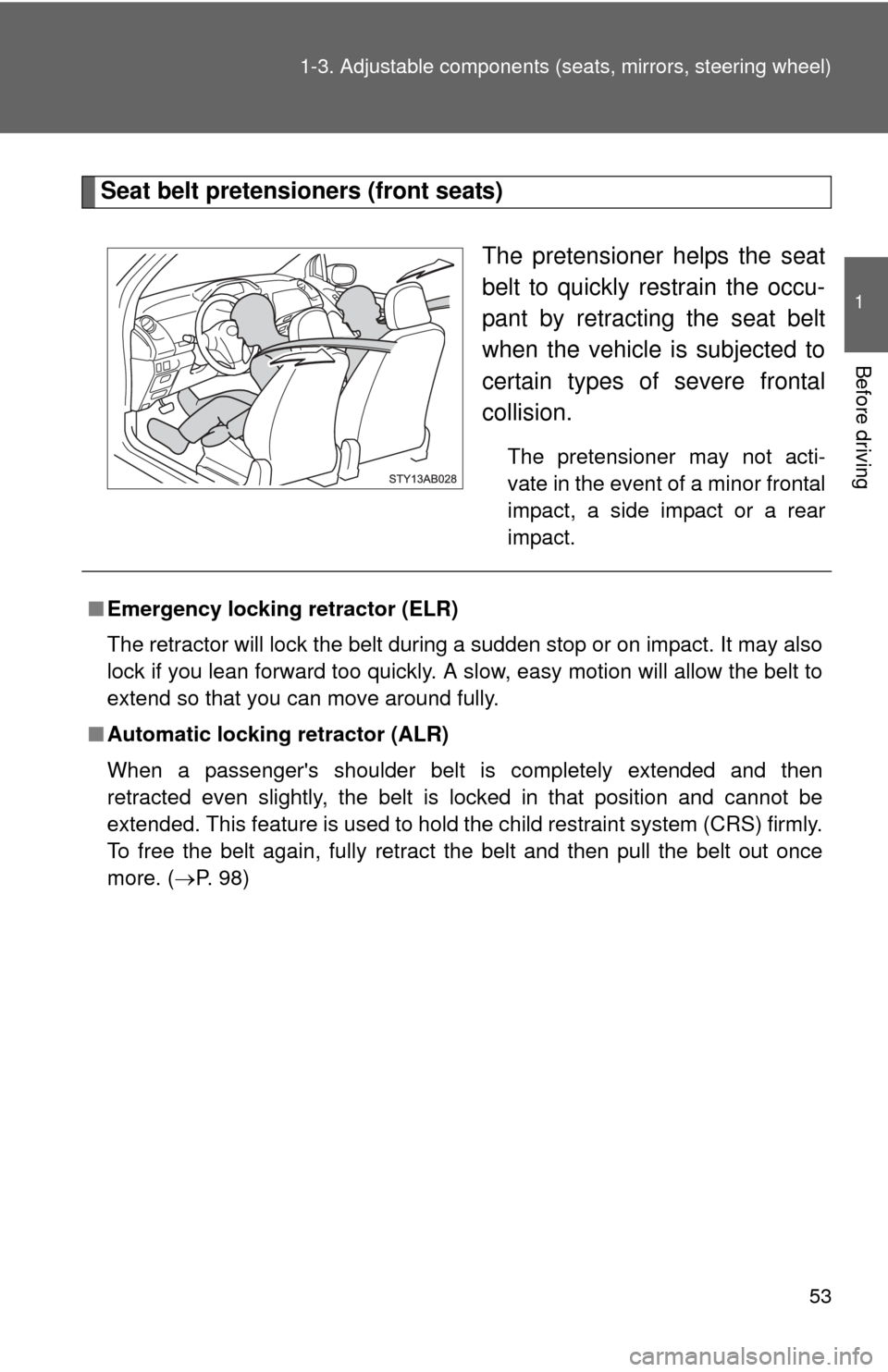Page 35 of 388
35
1
1-2. Opening, closing and locking the doors
Before driving
Back door
The back door can be opened using the back door opener. The back
door can be locked/unlocked using a key, wireless remote control or
door lock switch.
■ Back door opener
Push
Raise
■ Wireless remote control (if equipped)
P. 2 8
■ Key
Unlocks the back door
Locks the back door
■ Door lock switches (if equipped)
P. 3 2
Page 36 of 388
36 1-2. Opening, closing and locking the doors
■When closing the back door
CAUTION
■Caution while driving
Keep the back door closed.
This not only keeps personal belongings from being thrown out, but also pre-
vents exhaust gases from entering the vehicle.
■ To avoid accident or injury
Push the back door to shut from the outside. Do not use only the back door
handle to close the back door.
Lower the back door using the back door
handle, and make sure to push the back
door down from the outside to close it.
Page 38 of 388
38 1-3. Adjustable components (seats, mirrors, steering wheel)
■Moving the front passenger’s seat (3-door models only)
For easy access to the rear seat.
Lift up the seatback lock release lever.
The seat will slide forward.
Move the seat to the front-most position.
After rear passengers are in, lift up the seatback and return the seat until it
locks.
Front passenger’s seat Seat position adjustment
lever
Seatback angle adjustment
lever
Seatback lock release lever
(3-door models only)
Page 39 of 388
39
1-3. Adjustable components (s
eats, mirrors, steering wheel)
1
Before driving
CAUTION
■Seat adjustment
●Do not recline the seat more than necessary when the vehicle is in motion
to reduce the risk of sliding under the lap belt.
If the seat is too reclined, the lap belt may slide past the hips and apply
restraint forces directly to the abdomen or your neck may contact the
shoulder belt, increasing the risk of death or serious injury in the event of
an accident.
● After adjusting the seat, make sure that the seat is locked in position.
■ After returning the seatback
Push and pull the seatback to confirm that it is securely locked.
■ Caution while driving
Never operate the seatback lock release lever.
Page 44 of 388

44 1-3. Adjustable components (seats, mirrors, steering wheel)
CAUTION
■Seat adjustment
●Do not recline the seat more than necessary when the vehicle is in motion
to reduce the risk of sliding under the lap belt. If the seat is too reclined,
the lap belt may slide past the hips and apply restraint forces directly to the
abdomen or your neck may contact the shoulder belt, increasing the risk of
death or serious injury in the event of an accident.
● After adjusting the seat, make sure that the seat is locked in position.
■ After returning the seatback to the upright position
Observe the following precautions. Failure to do so may result in death or
serious injury.
● Make sure that the seatback is securely locked in position by lightly rock-
ing it back and forth.
● Check that the seat belts and buckles are not twisted or caught under the
seat.
● Arrange the seat belts in the proper positions for ready use.
NOTICE
■Stowing the seat belts
The seat belts and the buckles must be stowed before you fold down the
rear seat backs.
■ When returning the seatback to the upright position
Do not pull the pocket that stores the seat belt comfort guide.
Page 45 of 388
45
1
1-3. Adjustable components (seats, mirrors, steering wheel)
Before driving
Head restraints
Front seatsVertical adjustment
Push and hold the lock release
button when lowering the head
restraint.
Removal
Pull the head restraint up while
pushing the lock release but-
ton.
Lock
release
button
Page 46 of 388
46 1-3. Adjustable components (seats, mirrors, steering wheel)
Rear seats (split rear seats)
Vertical adjustment
Push and hold the lock release
button when lowering the head
restraint.
Removal
Pull the head restraint up while
pushing the lock release but-
ton.
Rear seats (non-split rear seat)
Vertical adjustment
Push and hold the lock release
button when lowering the head
restraint.
Removal
Pull the head restraint up while
pushing the lock release but-
ton.
Lock
release
button
Lock release
button
Page 53 of 388

53
1-3. Adjustable components (s
eats, mirrors, steering wheel)
1
Before driving
Seat belt pretensioners (front seats)
The pretensioner helps the seat
belt to quickly restrain the occu-
pant by retracting the seat belt
when the vehicle is subjected to
certain types of severe frontal
collision.
The pretensioner may not acti-
vate in the event of a minor frontal
impact, a side impact or a rear
impact.
■Emergency locking retractor (ELR)
The retractor will lock the belt during a sudden stop or on impact. It may also
lock if you lean forward too quickly. A slow, easy motion will allow the belt to
extend so that you can move around fully.
■ Automatic locking retractor (ALR)
When a passenger's shoulder belt is completely extended and then
retracted even slightly, the belt is locked in that position and cannot be
extended. This feature is used to hold the child restraint system (CRS) firmly.
To free the belt again, fully retract the belt and then pull the belt out once
more. ( P. 98)